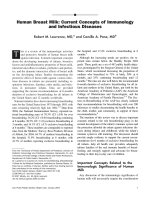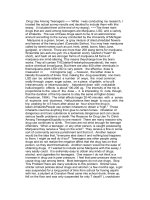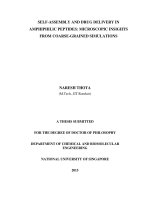Therapeutics and drug designing against infectious diseases using synthetic enzymology
Bạn đang xem bản rút gọn của tài liệu. Xem và tải ngay bản đầy đủ của tài liệu tại đây (1.77 MB, 136 trang )
THERAPEUTICS AND DRUG DESIGN AGAINST INFECTIOUS
DISEASES USING SYNTHETIC ENZYMOLOGY
AISHWARYA. S
NATIONAL UNIVERSITY OF SINGAPORE
2013
THERAPEUTICS AND DRUG DESIGN AGAINST INFECTIOUS
DISEASES USING SYNTHETIC ENZYMOLOGY
AISHWARYA. S
M.SC (DUAL), SRM UNIVERSITY,
INDIA
A THESIS SUBMITTED
FOR THE DEGREE OF MASTER OF SCIENCE
DEPARTMENT OF BIOCHEMISTRY
NATIONAL UNIVERSITY OF SINGAPORE
2013
DECLARATION
I hereby declare that the thesis is my original work and it has been written
by me in its entirety. I have duly acknowledged all the sources of
information which have been used in the thesis.
This thesis is also not been submitted for any degree in any university
previously.
Aishwarya. S
12 February 2013
Acknowledgement
First and foremost, I would like to thank my supervisor Dr. Yew Wen Shan, for his guidance and
support throughout this lengthy undertaking. He has been a great support for me throughout.
I am grateful to the National University of Singapore for providing me the Graduate Research
Scholarship throughout my candidature.
Many a thanks to the past and present members of Biochemistry department and the lab
members for their various advice, assistance, entertainment and for creating a great working
environment throughout my stint at NUS.
I would also like to thank Prof. K. Swaminathan who helped me with his suggestions on my
thesis.
Finally thanks to my family and friends for their love, support and forbearance.
Table of contents:
Acknowledgements
Table of contents
List of tables and graphs
List of figures
Abstract
PART 1: Towards the development of inhibitor against the Shikimate pathway
enzyme, 3-dehydroquinate synthase from Enterococcus faecalis (EfaroB)
1.
Introduction
1.1 Drug Resistance- A serious threat
2
1.2 Enzymes in the Shikimate pathway
3
1.3 Essentiality of Shikimate pathway
4
1.4 Shikimate pathway as a viable drug target
6
1.5 Known inhibitors of the pathway
7
1.6 Specific aims of the project
8
1.7 Enterococcus faecalis- A clinical pathogen
8
1.8 Enzyme mechanism catalyzed by DHQS from Enterococcus faecalis
9
1.9 Natural products as EfaroB inhibitors
i|Page
2
10
2. Materials and Methods
11
2.1 Materials
11
2.2 Cloning protocol
11
2.3 Production of electrocompetent cells
12
2.4 Protein Expression and purification
13
2.5 Cloning, expression and purification of Dehydroquinate Synthase (DHQS) from
Enterococcus fecalis (EFaroB)
3.
4.
14
2.6 Coupled enzyme Assays of EFaroB and EFaroF
14
2.7 Identification of potential inhibitors of aroB
15
Results for EfaroB purification
17
3.1 SDS-PAGE
17
3.2 Assay Results of EfaroB
18
3.3 Screening for inhibitors
18
Cloning and expression of enzymes for combinatorial biosynthesis
19
4.1. Combinatorial Biosynthesis
19
4.2 Enzymes for combinatorial biosynthesis
19
4.2.1 Chalcone isomerases
20
4.2.1.1 Amplification of Chalcone isomerases from Arabidopsis
20
4.2.1.2 Cloning of Chalcone isomerases
20
4.2.1.3 Expression and Solubility Screening Studies
20
4.3 DMR6
4.3.1 Cloning, Expression and Screening for solubility in DMR6
21
21
4.3.2 Enhancing solubility using β-galactosidase α-complementation 22
ii | P a g e
4.4.1 LDOX
23
4.4.2 Methods
24
4.4.2.1 Amplification and Cloning
24
4.4.2.2 Expression of LDOX in pET15b
24
4.5.1 Hydroxy cinnamoyl transferases (HCT)
24
4.5.2 Amplification and Cloning in to Tom15b
25
5. Results and Discussion
26
5.1 Chalcone Isomerases
26
5.2 Results of DMR6
32
5.3 Cloning results of HCT
41
6. Conclusion
43
7. Future work
45
PART 2: Elucidating the mechanism of OMPDC-catalyzed reaction on a KGPDCscaffold
8. Introduction
48
8.1 Opportunistic enzyme evolution
49
8.2 Functionally diverse enzyme suprafamilies
49
iii | P a g e
8.2.1 3-ketogulonate 6-phosphate decarboxylase (KGPDC)
50
8.2.2 D-arabino-Hex-3-ulose 6-phosphate synthase (HPS)
52
8.2.3 D-ribulose 5-phosphate 3-epimerase (RPE)
53
8.3Beta-alpha barrel
9. Orotidine-5’-monophosphate decarboxylase (OMPDC)
54
56
9.1 Introduction
56
9.2 Structural information of OMPDC
57
9.3 Proposed Mechanisms of Catalysis of OMPDC- catalyzed reactions
58
9.4 Aim of our project
64
9.5 Our hypothesis for the mechanism of OMPDC-catalyzed reaction
64
9.5 Selection of KGPDC as a template to expound the mechanism of
OMPDC-catalyzed reaction
10. Materials and Methods
65
70
10.1 Site-Directed mutagenesis
70
10.2 OMPDC-negative E.coli selection strain (WSY102)
71
10.3 Transformation of mutants in to WSY102
71
10.4 Complementation growth Studies
71
10.5 Purification of Methanobacter OMPDC
72
11. Results
73
11.1 Aerobic growth curves
73
11.1.1 Complementation growth curve of Wildtype MtOMPDC in auxotrophic
strain (WSY102)
11.1.2 Complementation of growth in KGPDC mutants
11.1.2.1 Results of E33K single mutants of KGPDC
73
74
74
11.1.2.2 Results of E33K/W117S double mutants of KGPDC 76
11.1.2.3 Results of W117S/G171Q double mutants of KGPDC 77
iv | P a g e
11.1.2.4 Results of E33K/G171Q double mutants of KGPDC
80
11.1.2.5 Results of E33K/W117S/G171Q triple mutant
82
4.2 Results for Purification of MtOMPDC
84
12. Discussion
86
13. Future work
88
PART 3: Targeted Drug Discovery against Plasmodium falciparum
14. Introduction
90
14.1 Aim of the project
90
14.2 Human OMPDC
90
14.3 Plasmodium’s OMPDC
91
14.4 Inhibitors to Plasmodium OMPDC in the past
94
15. Species-specific design of Inhibitor
96
15.1 Differing residues between Plasmodium and Human OMPDC enzymes. 97
16. Discussion
100
17. Future Directions
101
References
v|Page
102
List of tables and graphs:
Tables:
Table 1: showing the mutant list based on the differing active site residues between KGPDC and
OMPDC
68
Graphs:
4.1.1 Complementation growth curve of Wildtype MtOMPDC
in auxotrophic strain (WSY102)
73
4.1.2.1 Results of E33K single mutants of KGPDC
74
4.1.2.1.a SgaH
74
4.1.2.1.b KEF
75
4.1.2.1.c KSP
75
4.1.2.1.d KST
76
4.1.2.2 Results of E33K/W117S double mutants of KGPDC.
76
4.1.2.3 Results of W117S/G171Q double mutants of KGPDC
77
4.1.2.3.a SgaH
78
4.1.2.3.b KEF:
78
4.1.2.3.c KSP
79
4.1.2.3.d KST
79
4.1.2.4 Results of E33K/G171Q double mutants of KGPDC
vi | P a g e
80
4.1.2.4.a SgaH
80
4.1.2.4.b KEF
81
4.1.2.4.c KSP
81
4.1.2.4.d KST
82
4.1.2.5 Results of E33K/W117S/G171Q triple mutant:
82
4.1.2.5.a SgaH
83
4.1.2.5.b KEF
83
4.1.2.5.c KST
84
vii | P a g e
List of figures:
Part 1: Towards the development of inhibitor against the Shikimate
pathway enzyme, 3-dehydroquinate synthase
1.1: The seven step reaction catalyzed by Shikimate Pathway.
4
1.2: The end product of the Shikimate pathway, Chorismate
branches in to a number of secondary metabolites.
6
1.3: Inhibitors of Shikimate pathway enzymes
8
1.4: Reaction catalyzed by 3-dehydroquinate synthase (aroB).
10
2.1: Coupled enzyme assay for EFaroB.
15
3.1: SDS-PAGE for large scale purification of EFaroB
using Tom15b vector.
17
4.1: Reaction catalyzed by Leucoanthocyanidin
viii | P a g e
dioxygenase (LDOX).
23
4.2: Amplification results of LDOX.
24
4.3: Reaction catalyzed by Hydroxy cinnamoyl transferase (HCT). 25
5.1: Isomerization reaction catalyzed by Chalcone Isomerase (CI). 26
5.2: Amplification result of the Chalcone isomerase, CI3.
27
5.3: Amplification result of the dioxygenase, TT5.
27
5.4: Expression results of CI3 in Tom15b and Rosetta2.
28
5.5: Solubility screening of CI3-1 in Tom15b and M9 medium after 1 and 2 hours
of induction with 0.5 mM IPTG.
28
5.6: Screening of CI3-2 in Tom15b and M9 medium.
29
5.7: Screening of CI3-3 in Tom15b and M9 medium.
29
5.8: Screening of CI3-4 in Tom15b and M9 medium at 25 ̊ C.
30
5.9: Screening of CI3 in pET20b and M9 medium.
30
5.10: Screening of CI3 in pET20b and M9 medium at 37 ̊ C.
31
5.11: CI3 in pET20b transformed in to BL21 and
over-expressed in LB at 37 ̊C.
31
5.12: CI3 in pET20b and Rosetta2 induced with 0.5mM IPTG.
32
5.13: Amplification results of DMR6 gene.
33
5.14: DMR6 cloned in to Tom15b vector and the extracted plasmid was amplified
using T7 pro and T7 term primers before sending for sequencing.
ix | P a g e
33
5.15: Amplification of the mutated pMALc4xA2 vector.
34
5.16: DMR6 cloned in to pMALc4xA2 vector.
34
5.17: Randomly mutated DMR6.
35
5.18: Solubility Screening of DMR6 in Tom15b at various induction time at 37 ̊ C
in M9 minimal medium.
35
5.19: Solubility Screening of DMR6 in Tom15b at various induction time at 37 ̊
C.
36
5.20: Solubility Screening of DMR6 in Tom15b at various induction time at 37 ̊ C
and 25 ̊ C .
37
5.21: Over-expression of DMR6-pET20b in BL21.
37
5.22: Nickel affinity purification of DMR6-pET20b.
38
5.23: Solubility screening of DMR6 in Tom15b vector. Screening was performed
at 37 ̊ C and 25 ̊ C at different time intervals starting from 1, 2, 3 and 15 hrs
induction with M9 minimal medium.
39
5.24: LDOX expression in pET15b vector and BL21 cell lines after induction
with 0.5 mM IPTG at 37 ̊ C and 6 hr induction time.
40
5.25: LDOX Expression at 30̊ C with 0.5mM IPTG after 3 hours
x|Page
induction.
40
5.26: LDOX expression at 18 ̊ C with 0.5mM IPTG.
41
5.27: Figure showing amplification of HCT.
41
5.28: Amplification result of Pseudomonas polyketide synthase,
PhID.
42
Part 2: Elucidating the mechanism of OMPDC-catalyzed reaction
on a KGPDC-scaffold
8.1: Reaction catalyzed by KGPDC through the formation of an enediolate
intermediate.
51
8.2: Figure showing KGPDC from E. coli.
51
8.3: Reaction catalyzed by HPS shows that the reaction mechanism is similar to
the KGPDC in that both requires a metal ion for the catalytic activity. 52
8.4: Reaction catalyzed by RPE.
53
8.5: Crystal structure of RPE obtained from PDB (1RPX) displaying a classical
(β/α)8-barrel fold.
55
9.1: Reaction catalyzed by OMPDC shows that the substrate OMP is converted in
to UMP through the formation of vinyl carbanion intermediate.
56
9.2: OMPDC of Methanobacter thermoautotrophicum.
58
9.3: Different mechanistic proposals for the reaction
xi | P a g e
catalyzed by OMPDC.
61
9.4 : The paradigm of Directed Evolution of enzymes. Iterative rounds of
mutation and selection will give rise to the target enzyme.
62
9.5: Figure to demonstrate the hypothesis of an OMPDC-catalyzed reaction
through the formation of vinyl carbanion intermediate.
66
9.6: Structural Superimposition of Methanobacter OMPDC and
E.coli KGPDC.
67
9.7: Superimposed structures of OMPDC and KGPDC showing conserved active
site residues.
67
9.8: Sequence alignment of KGPDC and OMPDC orthologues.
69
11.5 Purification of Methanobacter OMPDC at 37 ̊C.
85
Part 3: Targeted Drug Discovery against Plasmodium falciparum
14.1: Human UMPS (OMPDC-containing domain) showing active site
xii | P a g e
architecture.
91
14.2: Structure of Plasmodium OMPDC (2FFC) bound to UMP.
93
14.3: Close up snapshot of Plasmodium OMPDC bound to UMP.
94
14.4: Chemical structures of inhibitors used in the study of OMPDC. 95
15.1: Human and Plasmodium OMPDC differing catalytic residues.
98
15.2: Sequence alignment of OMPDC from different organisms shows a
conserved DKD motif.
xiii | P a g e
99
Abstract
A number of infectious diseases are known to be caused by microorganisms resulting in death and
impairment. Understanding the principle behind the emergence of the disease and the reason for the
multi-drug resistance of these pathogenic microorganisms is crucial, in order to develop an anti-infective
against these pathogens. Our work was to develop an antimicrobial drug against a Shikimate pathway
enzyme and to design inhibitors against the Plasmodium parasite’s Orotidine 5’-monophosphate
decarboxylase (OMPDC) enzyme. We also attempted to decipher the OMPDC-catalyzed mechanism on
a 3-keto-L-gulonate 6-phosphate decarboxylase (KGPDC) scaffold, as a means of understanding the
mechanism in detail. In the first part of the thesis, the enzyme 3-dehydroquinate synthase from
Enterococcus faecalis was expressed and purified and tested for its activity. A number of modifying
enzymes were also cloned, and attempts were made to express and purify them, for use in the
modification of side chains of the inhibitors in the process of combinatorial biosynthesis. The second
part of the thesis was a two-pronged approach, where, initially we attempted to understand the
mechanism catalyzed by OMPDC by replicating it on the scaffold of its related suprafamily member,
KGPDC. By understanding the mechanism, we hoped to develop inhibitors against the OMPDC enzyme
of the pathogens. Complementation growth studies were performed and the aerobic growth curves were
plotted. In the last part of the thesis, we tried to find the disparity between the human and Plasmodium’s
OMPDC enzymes with which we looked forward to a rational design of an inhibitor against
Plasmodium OMPDC, hoping that this inhibitor might have a minimal side-effect on the human host if it
is developed in to a drug. We found a number of key residues that were distinct between the human host
and the pathogen and we propose that if these differing residues can be targeted to develop an efficient
drug against the Plasmodium OMPDC enzyme, consequently, the drug might have a minimal attack if
administered to the host.
xiv | P a g e
Abbreviations:
PEP
Phosphoenol pyruate
DAHP
3-deoxy-D-arabino-heptulosonate 7-phosphate
ESPS
5-enolpyruvyl shikimate-3-phosphate synthase
EfaroB
3-dehydroquinate synthase from Enterococcus fecalis
DHQS
3-dehydroquinate synthase
VRE
Vancomycin resistant Enterococcus
NAD+
Nicotinamide adenine dinucleotide
NADH
Nicotinamide adenine dinucleotide reduced
Zn 2+
Zinc
Co 2+
Cobalt
PCR
Polymerase chain reaction
CIAP
Calf intestine Alkaline phosphatase
NEB
New England Biolabs
dNTP
deoxy nucleotide triphosphate
IPTG
Isopropyl β-D-1-thiogalactopyranoside
INT
Indole-nitrotetrazolium violet
DMF
Dimethyl formamide
SDS
Sodium dodecyl sulphate
PAGE
polyacrylamide gel electrophoresis
ONPG
O-nitrophenyl- β-D-galactopyranoside
OMPDC
Orotidine-5’-monophosphate decarboxylase
KGPDC
3-keto L-gulonate 6-phosphate decarboxylase
HPS
D-arabino-hex-3-ulose 6-phosphate synthase
RPE
D-ribulose 5-phosphate 3-epimerase
OMP
Orotidine -5’-monophosphate
UMP
Uridine 5’-monophosphate
BMP
6-hydroxy UMP
FUMP
5-fluoro UMP
FOMP
5-fluoro OMP
EO
1-(erythrofuranosyl) orotic acid
OPRT
orotate phosphoribosyltransferase
Aza-UMP
6-azauridine 5'-monophosphate
Part 1: Towards the development of inhibitors against the Shikimate pathway
enzyme, 3-dehydroquinate synthase
1
Chapter 1: Introduction
1.1
Drug Resistance- A serious threat
Antibacterial agents are compounds that either halt or completely inhibit the growth of
bacteria. Although there are several antimicrobials developed against the pathogenic species, the
growing number of multi-drug resistant pathogens poses a serious health threat to humans. There
is a pressing need for new drugs to be developed against these emerging drug-resistant
microorganisms. The microbes exhibit various modes of drug resistance [56], such as:
1)
Drug inactivation or modification.
2)
Alteration of target site.
3)
Alteration of metabolic pathway.
4)
Reduced drug accumulation. [1]
An important research interest centers on bringing about the alteration in bacterial
growth, which can be accomplished by modulating the flux of biochemical pathways, which in
turn result in a cascade of events leading to stasis or complete disruption of cell function and
growth. One such biochemical pathway that serves as an interesting area of research for potential
antibacterial and antifungal agents is the Shikimate pathway. The enzymes of the Shikimate
pathway are the prime targets for drug design as the pathway is essential in plants and microbes,
but absent in humans, consequently reducing the risk of potential adverse effects from drugs that
inhibit this pathway.
2
1.2
Enzymes in the shikimate pathway
The Shikimate pathway comprises of seven enzymatic steps, ultimately, giving rise to the
precursors of the aromatic amino acids such as phenylalanine, tyrosine and tryptophan [2]. The
biosynthesis of these amino acids is vital for the homeostasis of various plants, fungi and bacteria
[3]. In addition, this biochemical pathway generates aromatic precursors essential for folic acid
(p-aminobenzoic acid) and ubiquinone production [4].
A total of seven enzymes are responsible for the conversion of phosphoenol pyruate
(PEP) and erythrose 4-phosphate (E4P) to chorismate (Figure 1.1). Chorismate plays a key role
as it branches in to three pathways (Figure 1.2) - the first pathway leading to the biosynthesis of
phenylalanine and tyrosine, the second pathway leading to tryptophan biosynthesis and the third
pathway leading to folate and ubiquinone biosynthesis[2].
The first step of the shikimate pathway comprises of the condensation of the glycolytic
intermediate, Phosphoenol pyruate (PEP), a three-carbon compound and the Pentose Phosphate
pathway intermediate, D-erythrose 4-phosphate, a four-carbon compound to give rise to a sevencarbon 6-membered heterocyclic compound, 3-deoxy-D-arabino-heptulosonate 7-phosphate
(DAHP). In the second step, the ring oxygen is exchanged for the exocyclic C7 of DAHP to form
a highly substituted cyclohexane derivative (Garner & Hermann, 1984), 3-dehydroquinate [3].
The remaining five steps serve to introduce a side chain and 2 double bonds to the cyclohexane
ring. The end product of the Shikimate pathway, Chorismate, becomes a precursor substrate for
various primary and secondary metabolites through a series of anabolic catalytic sequences.
3
Figure 1.1: The seven enzymatic reactions of the Shikimate Pathway.
The condensation
reaction between PEP and D-erythrose 4-phosphate culminates in chorismate production.
1.3
Essentiality of the shikimate pathway
These aromatic amino acids not only serve as structural units of proteins, but also in turn,
serve as precursors to a range of secondary metabolites with aromatic ring structures, including
flavonoids, Vitamin K and lignin [3]. In plants, this pathway provides precursors for the
biosynthesis of various polyketides such as chalcones, stilbenes and flavonoids. These plant
polyketides are bioactive plant secondary metabolites that have a number of biological
4
reactivities, including anti-microbial, anti-inflammatory, and anti-cancer activities; many of these
metabolites act as phytoalexins, plant antibiotics that target crucial metabolic pathways of
disease producing microbial pathogens. Natural product libraries can be used to screen for
effective lead compounds in the process of drug discovery and development.
Primary metabolites such as quinones, which are an essential components in the Electron
Transport Chain (ETC), are derived from Chorismate metabolism. In addition, signaling
molecules such as phenyl propanoids are some of the products derived downstream of the
reaction. It is therefore apparent that the shikimate pathway is crucial and vital for the survival of
bacteria, fungi, apicomplexan parasites and plants [3].
5









